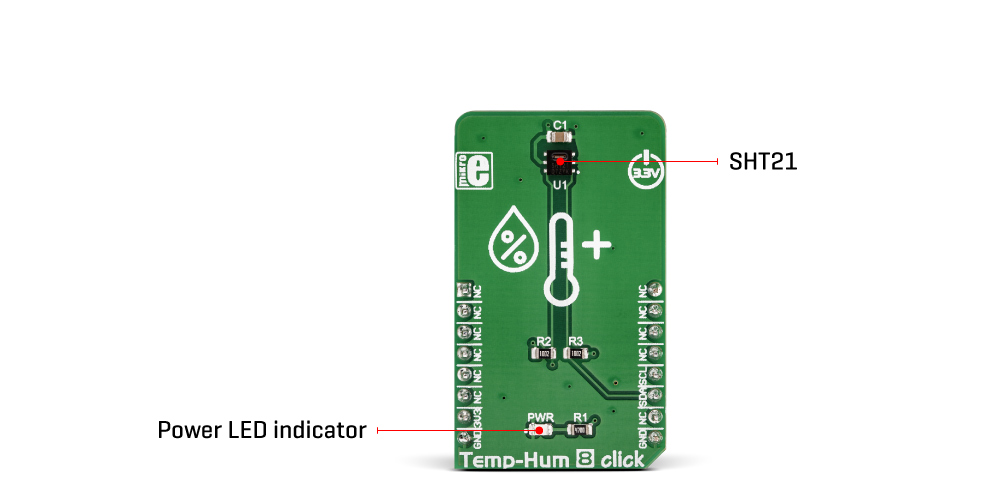Prices incl. GST
Out of Stock.
- Product Code: MIKROE-3263
- MPN: MIKROE-3263
The programmable sensor resolution allows you to select between 8/12 bits and 12/14 bits (temp/hum), which directly affects the power consumption. The sensor housing is made of epoxy with no Pb, Cd, or Hg parts, which guarantees the reliability and compatibility of Temp&Hum 8 click with RoHS and WEEE standards.
How does it work?
The sensor IC used on the Temp&Hum 8 click is the SHT21, a Humidity and Temperature Digital Sensor from Sensirion. This sensor is factory calibrated, allowing down to ±2% relative humidity tolerance (RH) and ±0.3°C thermal tolerance. However, the RH measurement of the sensor is affected by the temperature, therefore it is required to use the sensor at the temperature of the air, in which the humidity is measured. The humidity accuracy is also affected by the RH percentage: if both temperature and humidity are placed on a graph, it is possible to get a diagram of the RH accuracy as the function of RH percentage and temperature. One such diagram is presented in the datasheet of the SHT21 sensor, which can be found in the Downloads section, below.

The SHT21 IC is based on the CMOSens® technology, featuring the capacitive RH sensor and the bandgap temperature sensor. Besides the sensing elements, the IC incorporates an analog front end (AFE), which consists of A/D converter, OTP memory, and a logic section. The integrated A/D converter can be programmatically selected from the lowest 8/12-bit resolution, up to resolutions of 12/14 bits. The resolution selection affects the power consumption, as well as the data output rate. The response time might vary between 3ms for 8-bit resolution, up to 29ms for 14-bit resolution, for the RH readings. The resolution selection can be set within the so-called User register.
The SHT21 sensor also features an integrated heating element, used to evaporate condensation. The heating element can be simply activated by setting a bit in the User register. In the case when the heater is powered on, the power consumption might rise above the typical values.
The SHT21 sensor is also equipped with the brown-out status bit, located in the User register. This bit indicates the low power voltage: if the voltage drops below 2.25V, this bit will be set to 1, indicating a brown-out condition.
Temp&Hum 8 click uses the I2C interface, and it already features pull-up resistors on the I2C lines. It can be used out of the box. The provided click board™ library contains simple and easy to use functions, which simplify configuring and reading of the measurement data. These functions are demonstrated in the included example application and can be used as a reference for custom projects. These functions can be used in mikroC, mikroBASIC and mikroPASCAL compilers for all MCU architectures supported by MikroElektronika.
Specifications
| Type | Temperature / Humidity |
| Applications | It is a perfect choice for various consumer and industry related applications, such as the indoor weather stations, thermostats and humidistats, microenvironment centers, and similar applications |
| On-board modules | The SHT21, a Humidity and Temperature Digital Sensor from Sensirion |
| Key Features | High accuracy, good linearity, proven reliability, long-term stability, programmable resolution from 8 bits, up to 14 bits, an integrated heater, etc. |
| Interface | I2C |
| Input Voltage | 3.3V |
| Click board size | M (42.9 x 25.4 mm) |
Pinout diagram
This table shows how the pinout on Temp&Hum 8 Click corresponds to the pinout on the mikroBUS™ socket (the latter shown in the two middle columns).
Onboard settings and indicators
| Label | Name | Default | Description |
|---|---|---|---|
| PWR | PWR | - | Power LED indicator |
We provide a library for the Temp&Hum 8 click on our LibStock page, as well as a demo application (example), developed using MikroElektronika compilers. The demo can run on all the main MikroElektronika development boards.
Library Description
The library initializes and defines the I2C bus driver and drivers that offer a choice for writing data in the register and reads data from the register. The library includes the function for reading Temperature and Relative Humidity data and function for reading/writing data to user register. The user also has the function for default configuration device for measurement and function for device software reset.
Key functions:
float temphum8_getTemperature(uint8_t tempIn)- Functions for reading Temperature datafloat temphum8_getHumidity()- Functions for reading Relative Humidity datavoid temphum8_configuration(uint8_t cfg)- Functions for configuration device for measurement
Examples description
The application is composed of the three sections :
- System Initialization - Initializes I2C module
- Application Initialization - Initialization driver init, chip reset and default configuration;
- Application Task - (code snippet) - Reads Temperature and Humidity data and this data logs to USBUART every 1sec.
void applicationTask()
{
float Temperature;
float Humidity;
char demoText[ 50 ];
Temperature = temphum8_getTemperature(_TEMPHUM8_TEMPERATURE_IN_CELSIUS);
FloatToStr(Temperature, demoText);
mikrobus_logWrite(" Temperature : ", _LOG_TEXT);
mikrobus_logWrite(demoText, _LOG_TEXT);
mikrobus_logWrite(" C", _LOG_LINE);
Humidity = temphum8_getHumidity();
FloatToStr(Humidity, demoText);
mikrobus_logWrite(" Humidity : ", _LOG_TEXT);
mikrobus_logWrite(demoText, _LOG_TEXT);
mikrobus_logWrite(" RH", _LOG_LINE);
mikrobus_logWrite(" ---------------------- ", _LOG_LINE);
Delay_ms( 1000 );
}
The full application code, and ready to use projects can be found on our LibStock page.
Other mikroE Libraries used in the example:
I2C
Additional notes and information
Depending on the development board you are using, you may need USB UART click, USB UART 2 clickor RS232 click to connect to your PC, for development systems with no UART to USB interface available on the board. The terminal available in all MikroElektronika compilers, or any other terminal application of your choice, can be used to read the message.
mikroSDK
This click board is supported with mikroSDK - MikroElektronika Software Development Kit. To ensure proper operation of mikroSDK compliant click board demo applications, mikroSDK should be downloaded from the LibStock and installed for the compiler you are using.









